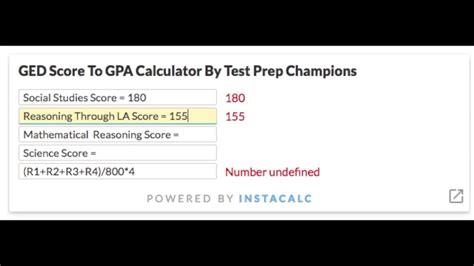Understanding the GED and GPA Scales
GED (General Educational Development) and GPA (Grade Point Average) are two distinct measurement systems used to assess academic achievement. The GED exam serves as an alternative to a high school diploma, while GPA indicates academic performance in traditional school settings. Understanding the conversion between these scales is crucial for students seeking to bridge the gap between non-traditional and traditional education pathways.

GED Score Range
The GED exam consists of four subtests: Reasoning Through Language Arts, Mathematical Reasoning, Science, and Social Studies. Each subtest is scored on a scale of 100 to 200, with a maximum possible overall score of 800.
GPA Scale
GPA is calculated based on a weighted average of grades earned in individual courses. The most common GPA scale ranges from 0.0 to 4.0, with each grade assigned a numerical value:
| Grade | Numerical Value |
|---|---|
| A | 4.0 |
| B | 3.0 |
| C | 2.0 |
| D | 1.0 |
| F | 0.0 |
Conversion Table: GED Score to GPA
The following table provides an approximate conversion between GED scores and GPA equivalents:
| GED Score Range | GPA Equivalent |
|---|---|
| 600-800 | 3.0-4.0 |
| 500-599 | 2.5-2.9 |
| 450-499 | 2.0-2.4 |
| 400-449 | 1.5-1.9 |
| Below 400 | Below 1.5 |
Note: This conversion is based on general guidelines and may vary depending on the specific institution and grading system used. It is recommended to consult with individual colleges or universities for precise conversion information.
Why the GED Score to GPA Conversion Matters
The GED score to GPA conversion is significant for several reasons:
- College and University Admissions: Many colleges and universities consider GPA as a key factor in admission decisions. Understanding the GED score to GPA conversion allows GED graduates to assess their academic standing and make informed choices about applying to higher education.
- Scholarships and Financial Aid: Scholarships and financial aid awards often require minimum GPA thresholds. Converting GED scores to GPA equivalents provides a common metric for students to qualify for these opportunities.
- Employment and Career Advancement: Employers may consider GPA as an indicator of academic success and employability. GED graduates can utilize the converted GPA to enhance their job applications and career potential.
Benefits of Converting GED Scores to GPA
- Quantifies Academic Achievement: Converted GPA provides a standardized measure of academic performance, allowing GED graduates to quantify their learning outcomes.
- Facilitates College and Career Planning: Understanding the GPA equivalent helps students plan their post-GED path by identifying appropriate colleges, universities, and career options.
- Improves Application Competitiveness: By converting GED scores to GPA, GED graduates can present their academic credentials in a manner that is comparable to traditional high school graduates, increasing their application competitiveness.
Considerations When Converting GED Scores to GPA
- Institution-Specific Requirements: Different colleges and universities may have varying requirements for GED score to GPA conversions. It is crucial to research the specific institution’s policies and guidelines.
- Subtest Scores: While the overall GED score is used for GPA conversion, institutions may also consider individual subject area scores. For example, a college requiring a GPA of 3.0 in science may give more weight to the GED Science subtest score.
- Additional Credentials: Some institutions may require additional credentials, such as work experience or portfolio reviews, in addition to GED score to GPA conversions.
Conclusion
Understanding the GED score to GPA conversion is essential for GED graduates seeking to pursue higher education, employment, and career advancement. By utilizing the conversion table and considering the benefits and considerations discussed, GED graduates can effectively bridge the gap between non-traditional and traditional education pathways and maximize their academic and professional potential.
